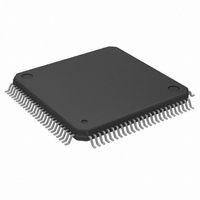M30800SFP-BL#U5 Renesas Electronics America, M30800SFP-BL#U5 Datasheet - Page 99

M30800SFP-BL#U5
Manufacturer Part Number
M30800SFP-BL#U5
Description
MCU 3/5V 0K,PB-FREE 100-QFP
Manufacturer
Renesas Electronics America
Series
M16C™ M16C/80r
Datasheet
1.M30803FGGPU3.pdf
(360 pages)
Specifications of M30800SFP-BL#U5
Core Processor
M16C/80
Core Size
16-Bit
Speed
20MHz
Connectivity
SIO, UART/USART
Peripherals
DMA, PWM, WDT
Number Of I /o
45
Program Memory Type
ROMless
Ram Size
10K x 8
Voltage - Supply (vcc/vdd)
2.7 V ~ 5.5 V
Data Converters
A/D 10x10b, D/A 2x8b
Oscillator Type
Internal
Operating Temperature
-20°C ~ 85°C
Package / Case
100-QFP
Lead Free Status / RoHS Status
Lead free / RoHS Compliant
Eeprom Size
-
Program Memory Size
-
Available stocks
Company
Part Number
Manufacturer
Quantity
Price
Part Number:
M30800SFP-BL#U5M30800SFP-BL#D5
Manufacturer:
Renesas Electronics America
Quantity:
10 000
- Current page: 99 of 360
- Download datasheet (4Mb)
M
R
R
e
E
1
v
J
6
1 .
0
C
(1) Transfer cycle
9
0 .
8 /
B
The transfer cycle consists of the bus cycle in which data is read from memory or from the SFR area
(source read) and the bus cycle in which the data is written to memory or to the SFR area (destination
write). The number of read and write bus cycles depends on the source and destination addresses. In
memory expansion mode and microprocessor mode, the number of read and write bus cycles also de-
pends on the level of the BYTE pin. Also, the bus cycle itself is longer when software waits are inserted.
Figure 11.6 shows the example of the transfer cycles for a source read. Figure 11.6 shows the destination
is external area, the destination write cycle is shown as two cycle (one bus cycle) and the source read
cycles for the different conditions. In reality, the destination write cycle is subject to the same conditions
as the source read cycle, with the transfer cycle changing accordingly. When calculating the transfer
cycle, remember to apply the respective conditions to both the destination write cycle and the source read
cycle. For example (2) in Figure 11.6, if data is being transferred in 16-bit units on an 8-bit bus, two bus
cycles are required for both the source read cycle and the destination write cycle.
0
0
(a) Effect of source and destination addresses
(b) Effect of external data bus width control register
(c) Effect of software wait
0
1
A
When 16-bit data is transferred on a 16-bit data bus, and the source and destination both start at odd
addresses, there are one more source read cycle and destination write cycle than when the source
and destination both start at even addresses.
When in memory expansion mode or microprocessor mode, the transfer cycle changes according to
the data bus width at the source and destination.
When the SFR area or a memory area with a software wait is accessed, the number of cycles is
increased for the wait by 1 bus cycle. The length of the cycle is determined by BCLK.
8
G
1. When transferring 16 bits of data and the data bus width at the source and at the destination is 8
2. When transferring 16 bits of data and the data bus width at the source is 8 bits (data bus width bit
3. When transferring 16 bits of data and the data bus width at the source is 16 bits (data bus width bit
u
7
o r
. g
0 -
bits (data bus width bit = “0”), there are two 8-bit data transfers. Therefore, two bus cycles are
required for reading and two cycles for writing.
= “0”) and the data bus width at the destination is 16 bits (data bus width bit = “1”), the data is read
in two 8-bit blocks and written as 16-bit data. Therefore, two bus cycles are required for reading
and one cycle for writing.
= “1”) and the data bus width at the destination is 8 bits (data bus width bit = “0”), 16 bits of data are
read and written as two 8-bit blocks. Therefore, one bus cycle is required for reading and two
cycles for writing.
u
1
0
p
0
, 2
0
2
0
0
5
Page 86
f o
3
2
9
11. DMAC
Related parts for M30800SFP-BL#U5
Image
Part Number
Description
Manufacturer
Datasheet
Request
R

Part Number:
Description:
MCU 3/5V 0K 100-QFP
Manufacturer:
Renesas Electronics America
Datasheet:

Part Number:
Description:
KIT STARTER FOR M16C/29
Manufacturer:
Renesas Electronics America
Datasheet:

Part Number:
Description:
KIT STARTER FOR R8C/2D
Manufacturer:
Renesas Electronics America
Datasheet:

Part Number:
Description:
R0K33062P STARTER KIT
Manufacturer:
Renesas Electronics America
Datasheet:

Part Number:
Description:
KIT STARTER FOR R8C/23 E8A
Manufacturer:
Renesas Electronics America
Datasheet:

Part Number:
Description:
KIT STARTER FOR R8C/25
Manufacturer:
Renesas Electronics America
Datasheet:

Part Number:
Description:
KIT STARTER H8S2456 SHARPE DSPLY
Manufacturer:
Renesas Electronics America
Datasheet:

Part Number:
Description:
KIT STARTER FOR R8C38C
Manufacturer:
Renesas Electronics America
Datasheet:

Part Number:
Description:
KIT STARTER FOR R8C35C
Manufacturer:
Renesas Electronics America
Datasheet:

Part Number:
Description:
KIT STARTER FOR R8CL3AC+LCD APPS
Manufacturer:
Renesas Electronics America
Datasheet:

Part Number:
Description:
KIT STARTER FOR RX610
Manufacturer:
Renesas Electronics America
Datasheet:

Part Number:
Description:
KIT STARTER FOR R32C/118
Manufacturer:
Renesas Electronics America
Datasheet:

Part Number:
Description:
KIT DEV RSK-R8C/26-29
Manufacturer:
Renesas Electronics America
Datasheet:

Part Number:
Description:
KIT STARTER FOR SH7124
Manufacturer:
Renesas Electronics America
Datasheet:

Part Number:
Description:
KIT STARTER FOR H8SX/1622
Manufacturer:
Renesas Electronics America
Datasheet:











